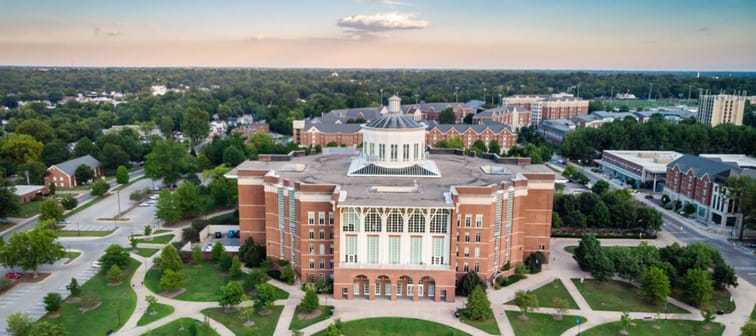Some pay a steeper price
In explaining why college tuition has become so expensive, many experts are quick to point to drastic state funding cuts. Adjusted for inflation, overall state funding for public two- and four-year colleges dropped a staggering $6.6 billion between 2008 and 2018, according to a report from The Center on Budget and Public Policies.
Between 2020 to 2021 alone, state funding for higher education dropped 6% across 37 states, says the National Education Association (NEA).
With fewer funds available, colleges have two choices to make it work: either scale back on amenities and programs or raise tuition.
And instead of scaling back, these colleges chose to scale up. The median flagship received more than double the revenue from undergraduate and graduate tuition and fees compared to 20 years ago — representing a whopping 64% price hike for the average student.
The trouble, the Journal points out, is cutting back on amenities and programs presents another problem: their institutions are suddenly less attractive to wealthier students. And in order to keep drawing from that pool, many colleges are opting to spend billions of dollars on construction projects, leaving them in debt and with no other way to pay it off than to reduce costs or raise fees.
For every dollar lost in state funding over the last two decades, the median flagship college upped tuition and fee revenue by nearly $2.40, which more than covered the cuts, says the Journal.
“Flagship schools are competing for talented students and families that can pay the sticker price,” Catharine Hill, an economist at education nonprofit organization Ithaka S&R and the former president of New York’s Vassar College, recently told CNN.
Kiss your credit card debt goodbye
Millions of Americans are struggling to crawl out of debt in the face of record-high interest rates. A personal loan offers lower interest rates and fixed payments, making it a smart choice to consolidate high-interest credit card debt. It helps save money, simplifies payments, and accelerates debt payoff. Credible is a free online service that shows you the best lending options to pay off your credit card debt fast — and save a ton in interest.
Explore better ratesColleges are competing to attract wealthy students
Take the University of Oklahoma, for example. The school borrowed hundreds of millions of dollars to afford building upgrades and new dormitories. Meanwhile, tuition and fees there have climbed by 166% since 2002 — marking the largest amount spent by any flagship.
The university also spent $14.3 million to buy and renovate an 18th century monastery in Arezzo, Italy, for its study abroad program. The university said it covered the costs with private gifts and university funds.
“We levered up the balance sheet to avoid dealing with [financial] reality,” university president Joseph Harroz Jr. told the Journal, indicating “there was an arms race” across higher education institutions.
The University of Oklahoma failed to hold to budget plans in previous years, Harroz said, but added that since 2018, it has reduced expenses by $143 million at its main campus in Norman.
Students are left with the higher bills
Today, the average cost per year has risen to $42,162 for attending a private college, $23,6320 for attending an out-of-state public university and $10,662 for in-state residents at public universities, according to an analysis by U.S. News & World Report.
These price hikes, the NEA says, are a major factor in what’s driving America’s student debt crisis. And a crisis it certainly is, with over 43 million Americans now on the hook for $1.6 trillion in student loans, which they will have to resume repaying this month. Many of those borrowers were unprepared to start making payments again, as payments resumed Oct. 1.
“Students do not have the resources right now to continue to foot the bill for all of the things that the university wants to do,” Crispin South, a 2023 Oklahoma graduate, told the Journal.
“You can’t just continue to raise revenue by turning to students.”
The richest 1% use an advisor. Do you?
Wealthy people know that having money is not the same as being good with money. Advisor can help you shape your financial future and connect with expert guidance . A trusted advisor helps you make smart choices about investments, retirement savings, and tax planning. Try Advisor now.








